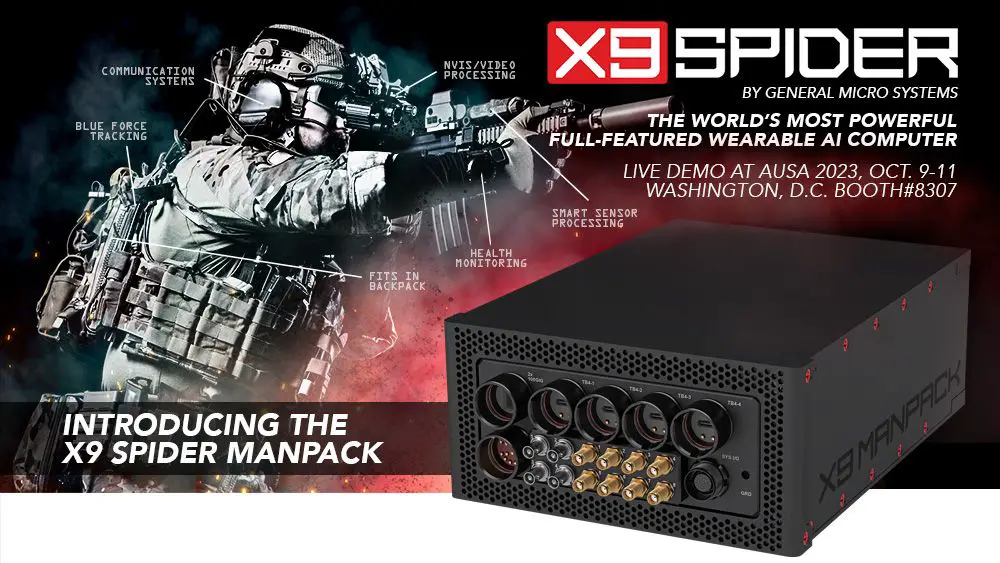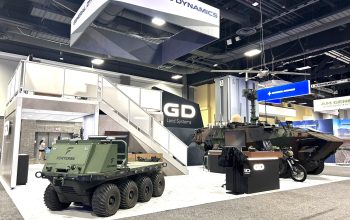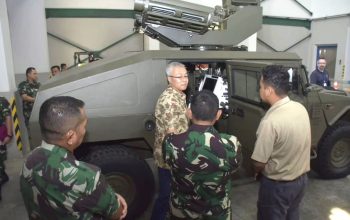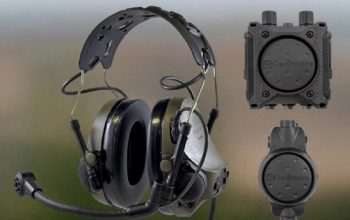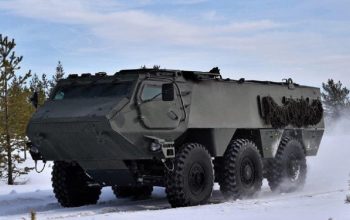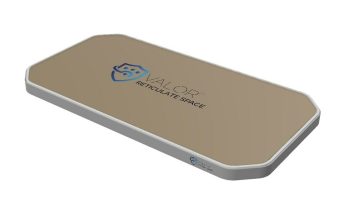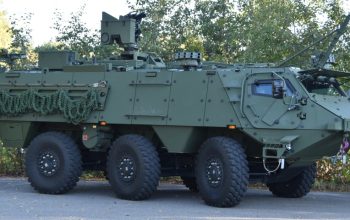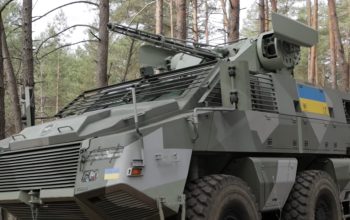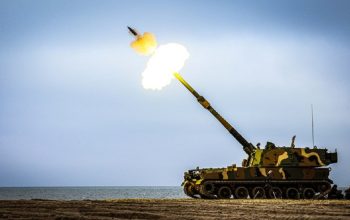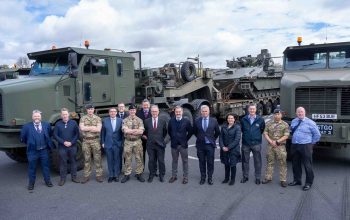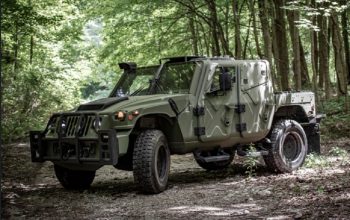General Micro Systems (GMS) today announced that the X9 Spider Mission Computer has been chosen by Research Innovations (RII) to create the company’s latest electronic warfare/signals intelligence (EW / SIGINT) product. Because of the X9’s tiny, rugged form-factor; flexible add-in I/O; high-density shared DDR4 memory, and closely coupled CPU/GPU architecture, RII is actively investing in the development of a battlefield-deployable product. Pairing GMS’s small form factor X9 hardware with RII’s unique ability to empower edge artificial intelligence (AI) and wideband RF processing will enable new cyber applications on previously unavailable platforms. RII has ordered the X9 Spider Mission Computer fully equipped with I/O and an NVIDIA® A4500 GPU. GMS has also customized the X9 Spider’s development platform—the “mezzanine test board” (MTB)—to meet RII’s unique specifications for integrating Epiq Solution’s software-defined radio (SDR). RII’s initial plans for the X9 Spider Mission Computer are for on-the-battlefield mobile, portable and vehicle-mounted use in classified EW / SIGINT applications. It aims to succeed Photon, the wideband accelerated RF processing platform, creating a next-generation solution and doing so in a significantly reduced form factor. Initial deployment of the RF-programmable cyber product is hundreds per year.
“It’s a game-changer,” said Bill Urrego, inventor of Photon while at the MITRE Corporation, and now an Engineering Fellow at RII. Urrego served as a senior principal engineer designing RF systems for the Army’s Program Manager Electronic Warfare & Cyber (PM-EW&C)—systems like TLS-BCT, which use Photon and NVIDIA GPU’s for AI / ML EW / SIGINT capabilities. “We are forging a generational breakthrough in distributed edge sensors with Spectrum access to 200 MHz of bandwidth using our embedded heterogeneous compute stack.”
The smaller form factor represents a reduction in 10x SWaP. The X9 Spider Mission Computer is about 2 x 4.75 x 6 inches, and literally fits in the palm of the hand. As well, it will run the same core RII software as on the rackmount servers but requires 60 cubic inches vs approximately 8,000 cubic rackmount inches. Rugged and waterproof, X9 Spider takes up less than 1 percent of the space (!), weighs under 3 pounds, can run on a standard soldier battery, and is stout enough to operate from -40°C to +85°C in the rain. For perspective, 133 X9’s would fit in the same rackmount space, offering that much additional EW RF processing. X9 Spider Mission Computer now blows open the possibilities for EW / SIGINT RF cyber processing in previously unavailable ways. The need for tactical, battlefield SDR products is acute. From receiving and identifying signals, to spoofing and jamming them, small passive and active SIGINT and EW products can be added to ground vehicles, UAS, airborne fighter jets, and even dismounted soldiers and Marines.
“The nature of warfare is changing,” said Ben Sharfi, CEO and Chief Architect at GMS. “At-the-edge computing clearly is better than moving data back CONUS for processing. But the sweet spot is adding RF and AI capabilities to anything and everything that can benefit from local processing and instantaneous results.” The entire X9 Spider family of rugged small form factor computers, AI, networking, storage and display products was created to make local on-the-battlefield processing and connectivity a reality. “Next-generation platforms like aircraft, vehicles, UAS and sensor systems require next-generation capabilities to maximize computing resources in lean, flexible and cost-effective ways,” Sharfi said. “By breaking the outdated and needlessly expensive, centralized ATR-style board-and-chassis paradigm into Thunderbolt™ technology-connected distributed compute modules, the X9 Spider family gives designers ruggedized, as-needed capabilities to solve any compute problem in any environment—from the smallest enclosure to the largest C5ISR system.” Rugged X9 Spider modules are small and modular, plug-and-play, and emphasize flexibility over ATR chassis’ physical and electrical constraints. An X9 module literally fits in the palm of your hand like a cell phone.
Built for limitless expandability, the X9 Spider family is based on brand-new, patent-pending mechanical features that allow devices to stack and interconnect electrically, physically and thermally but literally at light speed with minimal signal bottlenecks. X9 Spider connects directly to next-gen sensors without intermediate electronics—simplifying their connection to the electronic system—making the sensors themselves equally scalable and modular. This kind of upgradeability gives the DoD, primes and system developers limitless possibilities with very low upgrade costs. No one in the rugged industry has anything like X9 Spider because much of the technology was invented and patented by GMS. The revolutionary family includes:
- Interconnectivity via the COTS open standard Thunderbolt™ 4 technology, developed by Intel®and Apple.® As well, 100Gb Ethernet over fiber connects X9 Spider modules to each other and to other high-speed systems
- Mission Computer and AI Processor with a range of storage and network capabilities powered either by Intel’s® latest 11th-generation Xeon W (Tiger Lake-H) 8-core CPU, or by NVIDIA’s Jetson AGX Orin GPGPU with ARMcore engine, plus GPGPU CUDA and Tensor cores
- Six (6) companion X9 modules, including “Workstation” with removable storage and up to 14 sites for add-in I/O like MIL-STD-1553; Network “Switch” with four 100Gb and eight 10Gb Ethernet ports; “Storage” with removable canister and up to eight high-density M.2 or U.2 SSD storage devices; “GPGPU” with NVIDIA RTX-5000 or A4500 GPGPU and custom I/O module such as video frame grabber for autonomous driver sensors, and utility X9 Spider modules for “Power” and “Cooler”
- Improved reliability and robustness through the patent-pending QuadroLock™ active wedge lock technology, enabling X9 Spider modules to interlock to withstand severe noise, vibration and harshness while simultaneously transferring heat between modules for maximum cooling
- Cutting-edge, long-range and cost-efficient interconnects through the patent-pending LightBolt™ connector, supporting Thunderbolt™ 4 fiber or copper and 100W power in one cable
“X9 Spider’s interoperability not only lowers acquisition costs, but it enables modernization and upgrade programs to move past restrictive single-box architectures like VME and OpenVPX, and instead uses plug-and-play standards like Thunderbolt™ 4, 100Gigabit Ethernet and USB4 that are deployable anywhere on the platform,” Sharfi said. “This decentralizes computing, power distribution and heat dissipation while improving fault tolerance through redundancy or merely by physically separating critical functions. These capabilities required new mechanical and electrical innovations to achieve a truly MOSA-open, modular, distributed and scalable system that designers will love.”
The GMS X9 architecture includes 22 patents either filed for or granted.


